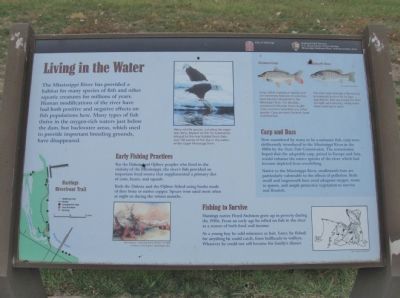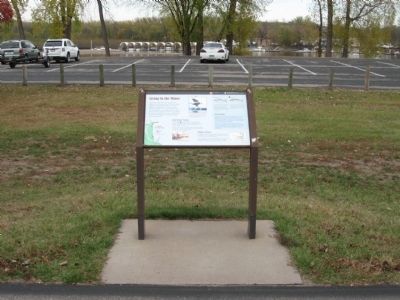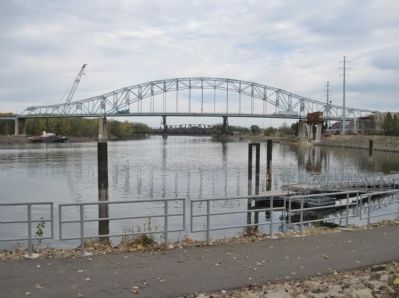Hastings in Dakota County, Minnesota — The American Midwest (Upper Plains)
Living in the Water
Early Fishing Practices
For the Dakota and Ojibwe peoples who lived in the vicinity of the Mississippi, the river's fish provided an important food source that supplemented a primary diet of corn, beans, and squash.
Both the Dakota and the Ojibwe fished using hooks made of deer bone or native copper. Spears were used most often at night or during the winter months.
Fishing to Survive
Hastings native Floyd Atchison grew up in poverty during the 1930s. From an early age he relied on fish in the river as a source of both food and income.
As a young boy he sold minnows as bait. Later, he fished for anything he could catch, from bullheads to walleye. Whatever he could not sell became his family's dinner.
Carp and Bass
Now considered by many to be a nuisance fish, carp were deliberately introduced to the Mississippi River in the 1880s by the State Fish Commission. The commission hoped that the adaptable carp, prized in Europe and Asia, would enhance the native species of the river, which had become depleted from overfishing.
Native to the Mississippi River, smallmouth bass are particularly vulnerable to the effects of pollution. Both small and largemouth bass need adequate oxygen, room to spawn, and ample protective vegetation to survive and flourish.
Erected by City of Hastings; National Park Service, U.S. Department of the Interior, Mississippi National River and Recreation Area.
Topics. This historical marker is listed in these topic lists: Industry & Commerce • Native Americans • Waterways & Vessels.
Location. 44° 44.896′ N, 92° 51.559′ W. Marker is in Hastings, Minnesota, in Dakota County. Marker can be reached from Lock and Dam Road, 0.3 miles north of 2nd Street West, on the right when traveling north. Marker is along the Hastings Riverfront Trail. Touch for map. Marker is in this post office area: Hastings MN 55033, United States of America. Touch for directions.
Other nearby markers. At least 8 other markers are within walking distance of this marker. Enjoying the River (about 700 feet away, measured in a direct line); Going with the Flow (approx. 0.2 miles away); Native Cultures (approx. 0.4 miles away); Downtown Develops (approx. 0.4 miles away); One Neighborhood, Many Stories (approx. 0.4 miles away); American Legion Veterans Memorial (approx. 0.4 miles away); Hastings, Minnesota (approx. 0.4 miles away); Spiral Bridge (approx. 0.4 miles away). Touch for a list and map of all markers in Hastings.
More about this marker. [photo captions, clockwise from top]
• Many wildlife species, including the eagle seen here, depend on fish for sustenance. Integral to the river habitat food chain, over 130 species of fish live in the waters of the Upper Mississippi River.
• Common Carp. Carp, which reproduce rapidly and are extremely abundant in the Mississippi River. For decades, commercial fisheries have caught more common carp than any other species. Carp are used for both food and fertilizer.
• Smallmouth Bass. The river near Hastings is becoming increasingly known for its bass population. Bass are prized for their strength and tenacity, which make them exciting to catch. Joseph Tomelleri
• Rev. Glenn Atchison
• Seth Eastman, "Spearing Fish in Winter," ca. 1868 Architect of the Capitol, Washington, D.C.
Also see . . . Mississippi National River and Recreation Area. Common Carp in the Upper Mississippi. (Submitted on November 7, 2011.)
Credits. This page was last revised on June 16, 2016. It was originally submitted on November 7, 2011, by Keith L of Wisconsin Rapids, Wisconsin. This page has been viewed 571 times since then and 17 times this year. Photos: 1, 2, 3. submitted on November 7, 2011, by Keith L of Wisconsin Rapids, Wisconsin.


